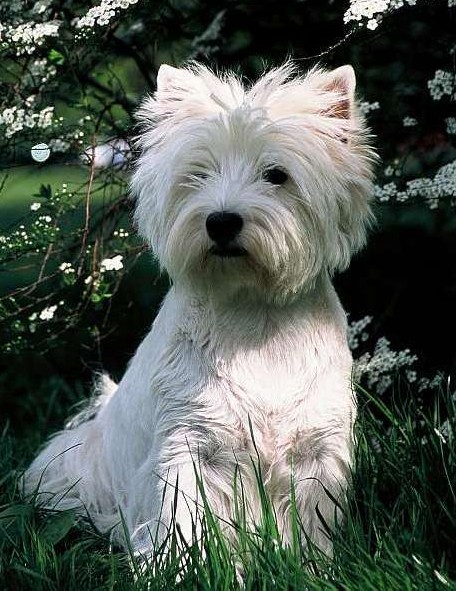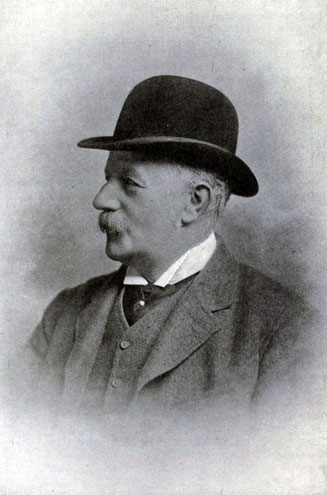|
Miniature Schnauzer
The Miniature Schnauzer is a breed of small dog of the Schnauzer type that originated in Germany in the mid-to-late 19th century. Miniature Schnauzers may have been developed from the smallest specimens of the Standard Schnauzer, or crosses between the standard and one or more smaller breeds such as the Affenpinscher, Miniature Pinscher, and Poodles, as farmers bred a small dog that was an efficient ratting dog. They are described as "spunky" but aloof dogs, with good guarding tendencies without some guard dogs' predisposition to bite. Miniature Schnauzers are recognized in four colors internationally: solid black, black and silver, salt and pepper, and white. It is the most popular Schnauzer breed, and remains one of the most popular worldwide, primarily for its temperament and relatively small size. As of 2020 it is the 19th most popular breed in the U.S. History The earliest records surrounding the development of the Standard Schnauzer in Germany come from the late 19th ... [...More Info...] [...Related Items...] OR: [Wikipedia] [Google] [Baidu] |
Verband Für Das Deutsche Hundewesen
Verband für das Deutsche Hundewesen (VDH) is Germany's Kennel club for dogs and represents Germany in the world federation Fédération Cynologique Internationale. It is headquartered in Dortmund, Germany. As the country-wide controlling body, the VDH represents 167 member organizations with more than 650,000 members. In addition, there are over 250 different breeds of dog in the VDH. History On July 16, 1906, the :de:Kartell der Stammbuchführender Spezialklubs für Jagd- und Nutzhunde was founded as the second German umbrella organization alongside the delegate commission; first president was :de:Albert de Gingins. In 1914, the cartel changed its name to "Kartell der Rassezuchtvereine und allgemeine Verbände" and in 1925 to "Deutsches Kartell für Hundewesen" (DKH). After Hitler's seizure of power in 1933, the Reichsverband für die Deutsche Hundewesen (RDH) was established as a "unitary organization" and the German Cartel for Dogs, Delegates Commission and Association ... [...More Info...] [...Related Items...] OR: [Wikipedia] [Google] [Baidu] |
Working Group (dogs)
A working dog is a dog used to perform practical tasks, as opposed to pet or companion dogs. Definitions vary on what a working dog is, they are sometimes described as any dog trained for and employed in meaningful work; other times as any dog whose breed heritage or physical characteristics lend itself to working irrespective of an individual animal's training or employment; and other times again it is used as a synonym for herding dog. Working dog types Roles performed by dogs that sometimes sees them classified as working dogs include: * Assistance dog trained to help a disabled person in some way, such as guiding a visually impaired person, opening doors or alerting to a ringing phone. * Carriage dog historically used to provide protection to carriage passengers or merchandise * Detection dog or sniffer dog, trained to detect for example drugs or land mines. * Draught dog traditionally used to pull dog carts * Guard dog used to protect buildings or livestock * Guide ... [...More Info...] [...Related Items...] OR: [Wikipedia] [Google] [Baidu] |
Docking (dog)
Docking is the removal of portions of an animal's tail. While docking and bobbing are more commonly used to refer to removal of the tail, the term cropping is used in reference to the ears. Tail docking occurs in one of two ways. The first involves constricting the blood supply to the tail with a rubber ligature for a few days until the tail falls off. The second involves the severance of the tail with surgical scissors or a scalpel. The length to which tails are docked varies by breed, and is often specified in the breed standard. Docking is illegal, or restricted, in many countries. Some dog breeds have naturally occurring bobtail lines. These appear similar to docked dogs but are a distinct naturally occurring phenotype. History Purpose Historically, tail docking was thought to prevent rabies, strengthen the back, increase the animal's speed, and prevent injuries when ratting, fighting, and baiting. Tail docking is done in modern times either for prophylactic, the ... [...More Info...] [...Related Items...] OR: [Wikipedia] [Google] [Baidu] |
Cropping (animal)
Cropping is the removal of part or all of the external flaps of an animal's ear. The procedure sometimes involves bracing and taping the remainder of the ears to train them to point upright. Almost exclusively performed on dogs, it is an old practice that was once done for perceived health, practical or cosmetic reasons. Veterinary science states there is no medical or physical advantage to the animal from the procedure,Slatter, Douglas H. (2002''Textbook of small animal surgery''3rd edition. Philadelphia: W.B. Saunders (imprint of Elsevier Health Sciences), 2896 pages, , p.1746 leading to concerns of animal cruelty over performing unnecessary surgery on animals. In modern times, cropping is banned in many nations, but is still legal in a limited number of countries. Where permitted, it is seen only in certain breeds of dog, such as the pit bull, Doberman Pinscher, Schnauzer, Great Dane, Boxer and Cane Corso. History and purposes In 2000, veterinarian Bruce Fogle wrote: ... [...More Info...] [...Related Items...] OR: [Wikipedia] [Google] [Baidu] |
Hypoallergenic Dog Breed
A hypoallergenic dog breed is a dog breed (or crossbreed) that is purportedly more compatible with allergic people than are other breeds. However, prominent allergen researchers have determined that there is no basis to the claims that certain breeds are hypoallergenic and, while allergen levels vary among individual dogs, the breed is not a significant factor. The myth Though some studies suggest the possible existence of hypoallergenic dog breeds, there is too much variability to conclude that such a breed exists. According to researchers, claims about the existence of hypoallergenic dog breeds may have been fueled by unsubstantiated articles on the internet. The significant allergens are proteins found in the dog's saliva and dander. Some studies have suggested that the production of the allergen, and therefore human allergenic reaction, varies by breed, yet more recent scientific findings indicate that there are no significant differences between breeds in the generation o ... [...More Info...] [...Related Items...] OR: [Wikipedia] [Google] [Baidu] |
Moulting
In biology, moulting (British English), or molting (American English), also known as sloughing, shedding, or in many invertebrates, ecdysis, is the manner in which an animal routinely casts off a part of its body (often, but not always, an outer layer or covering), either at specific times of the year, or at specific points in its life cycle. In medieval times it was also known as "mewing" (from the French verb "muer", to moult), a term that lives on in the name of Britain's Royal Mews where the King's hawks used to be kept during moulting time before becoming horse stables after Tudor times. Moulting can involve shedding the epidermis (skin), pelage (hair, feathers, fur, wool), or other external layer. In some groups, other body parts may be shed, for example, the entire exoskeleton in arthropods, including the wings in some insects. Examples In birds In birds, moulting is the periodic replacement of feathers by shedding old feathers while producing new ones. Feathers a ... [...More Info...] [...Related Items...] OR: [Wikipedia] [Google] [Baidu] |
Terrier Group
Terrier (from Latin ''terra'', 'earth') is a type of dog originally bred to hunt vermin. A terrier is a dog of any one of many breeds or landraces of the terrier type, which are typically small, wiry, game, and fearless. Terrier breeds vary greatly in size from just to over 60 kg (132 lb, e.g. Black Russian Terrier) and are usually categorized by size or function. There are five different groups of terrier, with each group having different shapes and sizes. History Most terrier breeds were refined from the older purpose-bred dogs. The gameness of the early hunting terriers was exploited by using them in sporting contests. Initially, terriers competed in events such as clearing a pit of rats. The dog that was fastest in killing all the rats won. In the eighteenth century some terriers were crossed with hounds to improve their hunting, and some with fighting dog breeds to "intensify tenacity and increase courage". Some of the crosses with fighting dogs, bull a ... [...More Info...] [...Related Items...] OR: [Wikipedia] [Google] [Baidu] |
Canadian Kennel Club
The Canadian Kennel Club (or CKC), founded in 1888 and chartered under the Animal Purebred Act, is one of the national kennel clubs of Canada. It maintains breed registry, breed registries services for those purebred dogs approved for its control by Agriculture and Agri-Food Canada, and provides governance for all CKC-approved dog conformation shows, dog trials and canine events. The CKC is a non-member partner with the Fédération Cynologique Internationale. See also *List of kennel clubs References External links * Kennel clubs Animal charities based in Canada {{Dog-stub ... [...More Info...] [...Related Items...] OR: [Wikipedia] [Google] [Baidu] |
United Kennel Club
The United Kennel Club (UKC) is a kennel club founded in 1898 in the United States. In contrast with the American Kennel Club, which is non-profit and which only clubs can join, the United Kennel Club is a profit-making corporation, open to individuals. History UKC was founded by Chauncey Z. Bennett, on February 10, 1898, after feeling that other dog registries in existence at the time catered too much to Conformation-only show dog owners or wealthy hobbyists, whom he called “the big city idle rich.”''UKC Centennial Book, The First 100 Years'', copyright 1997, UKC Bennett’s goal for UKC was to be a registry that recognized a wide range of breeds, as opposed to some of the working dog registries, which only recognized a handful of breeds. He envisioned UKC-registered dogs occupying a wide range of uses, from working, to companionship, to hunting. Bennett found a niche among the owners of working dogs, such as herding and hunting dogs. The first dog registered with UKC was a ... [...More Info...] [...Related Items...] OR: [Wikipedia] [Google] [Baidu] |
Utility Group
The Kennel Club ("KC") is the official kennel club of the United Kingdom. It is the oldest recognised kennel club in the world. Its role is to oversee various canine activities including dog shows, dog agility and working trials. It also operates the national register of pedigree dogs in the United Kingdom and acts as a lobby group on issues involving dogs in the UK. Its headquarters are on Clarges Street in Mayfair, London, with business offices in Aylesbury. The Kennel Club registration system divides dogs into seven breed groups. The Kennel Club Groups are: Hound group, Working group, Terrier group, Gundog group, Pastoral group, Utility group and Toy group. As of 2021, The Kennel Club recognised 222 breeds of dog. The Kennel Club licenses dog shows throughout the UK, but the only dog show it actually runs is Crufts. The show has been held since 1928 and attracts competitors from all over the world. It is held every March at the NEC, Birmingham, and includes the less ... [...More Info...] [...Related Items...] OR: [Wikipedia] [Google] [Baidu] |


.jpg)




